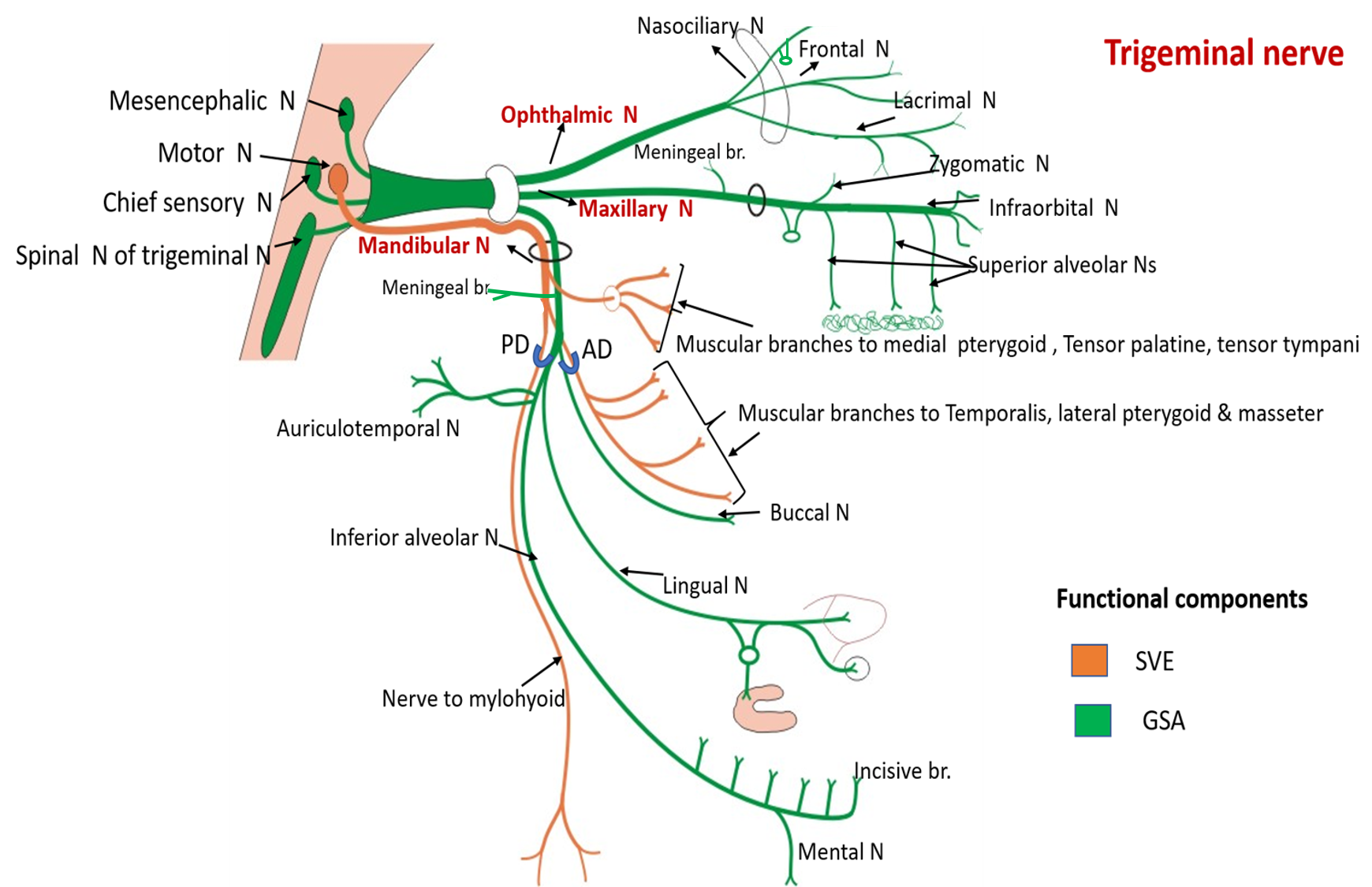Advertisements
What is the origin and subdivisions of trigeminal nerve?
- It is mixed (sensory and motor) nerve.
- It emerges from the ventral surface of pons at its junction with the middle cerebellar peduncle.
- It has two roots:
- Smaller medial motor root.
- Larger lateral sensory root.
- It has three divisions:
- Ophthalmic nerve
- Maxillary nerve
- Mandibular nerve
Name the nuclei, functional components of trigeminal nerve .
Following are the nuclei, functional components of trigeminal nerve:
| Function component | Nucleus | Structures innervated |
|---|---|---|
| SVE (Special visceral efferent) | Motor nucleus | All the 8 muscles derived from 1st branchial arch i.e. temporalis, masseter, medial pterygoid, lateral pterygoid, tensor veli palatini, tensor tympani, anterior belly of digastric and mylohoid. |
| GSA (General somatic afferent) | Main sensory nucleus | For touch and pressure sensations . |
| Spinal Nulceus of trigeminal nerve | For pain and temperature sensations . | |
| Mesencephalic Nucleus | For proprioceptive sensations | |
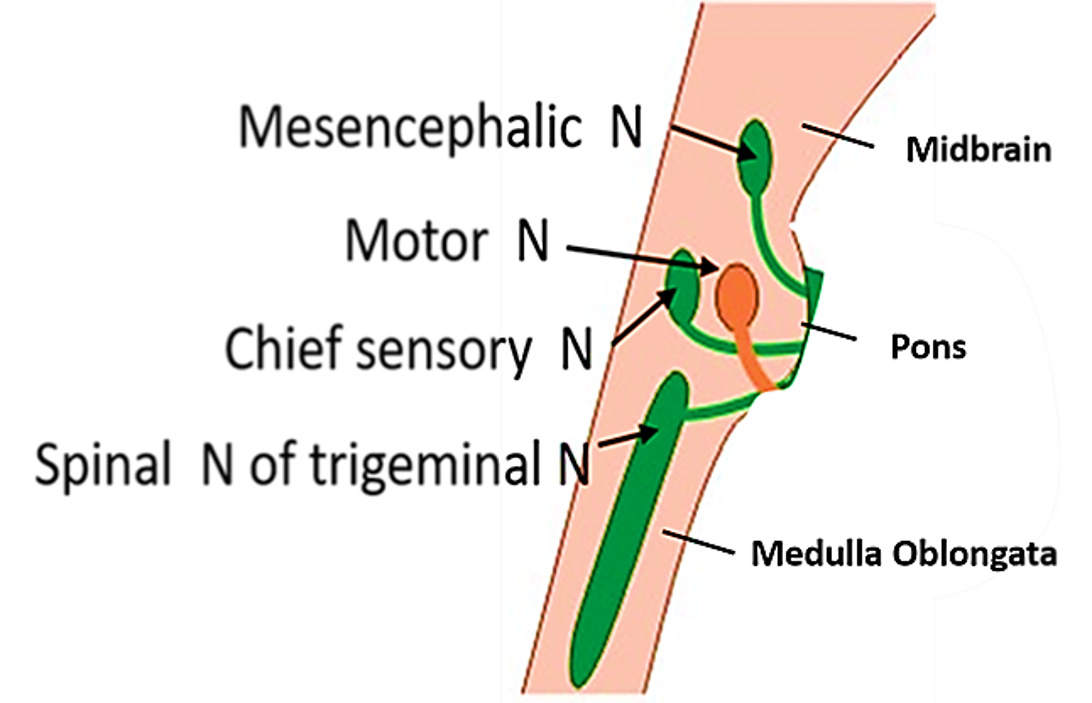
Describe the course, branches and structures supplied by opthalmic nerve.
- It is a pure sensory nerve.
- It arises from the anterior aspect of trigeminal ganglion.
- It then passes forward along the lateral wall of cavernous sinus.
- It divides into three branches – nasocilliary, frontal and lacrimal.
- The three branches exit cranial cavity by passing through the superior orbital fissure.
Branches of Ophthalmic nerve
- Lacrimal nerve
- Frontal nerve: it divides into
- Supraorbital and
- Supratrochlear nerves
- Nasocilliary nerve: gives following branches:
- Communicating branch to ciliary ganglion.
- 2-3 long ciliary branches
- Posterior ethmoidal nerve
- Anterior ethmoidal nerve
- Infratrochlear nerve
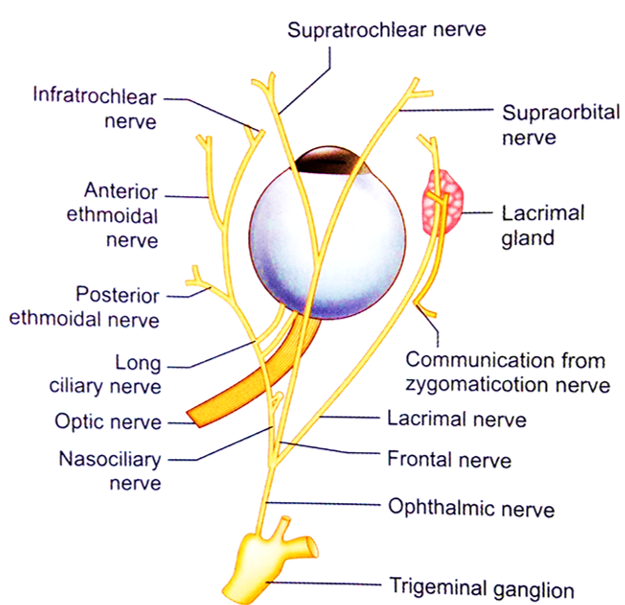
Structures supplied by ophthalmic nerve
- Sensory Innervation: Skin of anterior half of scalp, forehead, upper eyelid, cornea, conjunctiva, dorsum of nose, and dura of anterior cranial fossa, frontal, ethmoidal and sphenoidal air sinuses.
Describe the course, branches and structures supplied by maxillary nnerve.
- It is the 2nd division of trigeminal nerve.
- It is a pure sensory nerve.
- It commences from the anterior aspect of trigeminal ganglion.
- Passes along the lateral wall of the cavernous sinus.
- Leaves the cranial cavity via foramen rotundum.
- Enters pterygopalatine fossa.
- Continues as infraorbital nerve by passing through inferior orbital fissure and then passes through infra orbital groove and canal in the floor of orbit to reach the face.
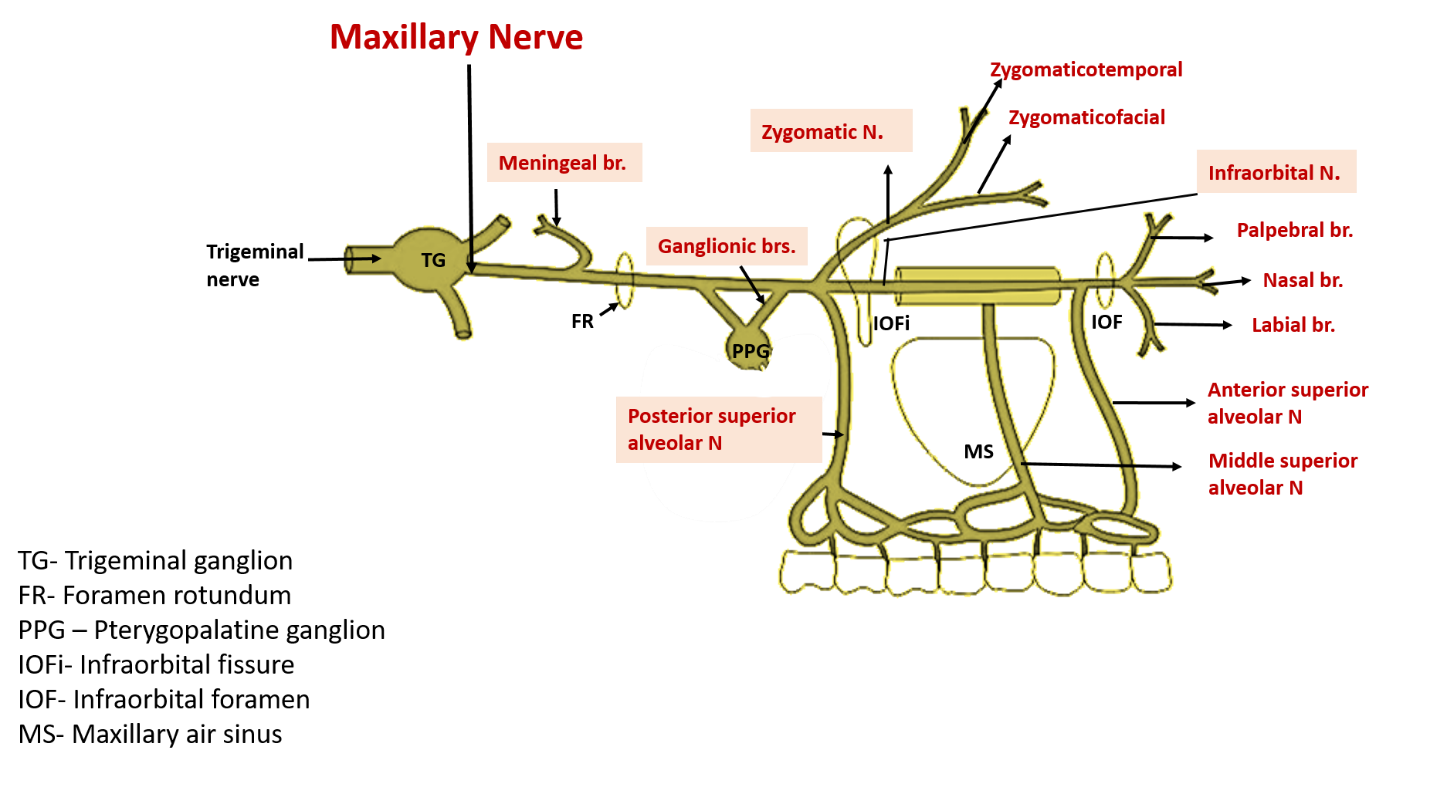
Branches of maxillary nerve
In the cranial cavity: Meningeal branch
In the pterygopalatine fossa:
- 2-3 ganglionic branches to pterygopalatine ganglion
- Posterior superior alveolar nerve
- Zygomatic nerve: divides into zygomaticotemporal and zygomaticofacial nerve.
- Infraorbital nerve: Maxillary nerve continues as infraorbital nerve. The infraorbital nerve gives following branches:
- In the infra orbital canal:
- Middle and anterior superior alveolar nerves
- On the face:
- Palpebral branch
- Nasal branch
- Labial branch
- In the infra orbital canal:
Structures supplied by maxillary nerve
Sensory Innervation – Skin of upper lip, lateral part of nose, upper part of cheek, anterior temple, mucosa of nose, upper jaw, upper teeth, palate, maxillary air sinus and dura of middle cranial fossa.
Describe the course, branches and structures supplied by mandibular nerve.
- Is the largest of the three divisions of trigeminal nerve
- Is a mixed nerve containing both sensory and motor fibers.
- Is the nerve of 1st pharyngeal arch and supplies all structures derived from this arch.
- It begins in the middle cranial fossa.
- It has two roots- large sensory and smaller motor.
- Motor root is attached to the pons. And sensory root arises from trigeminal ganglion.
- Both the roots pass through the foramen ovale to infratemporal fossa.
- The two roots join to form trunk of the mandibular nerve.
- The trunk then divides into:
- Anterior division (mainly motor)
- Posterior division (mainly sensory)
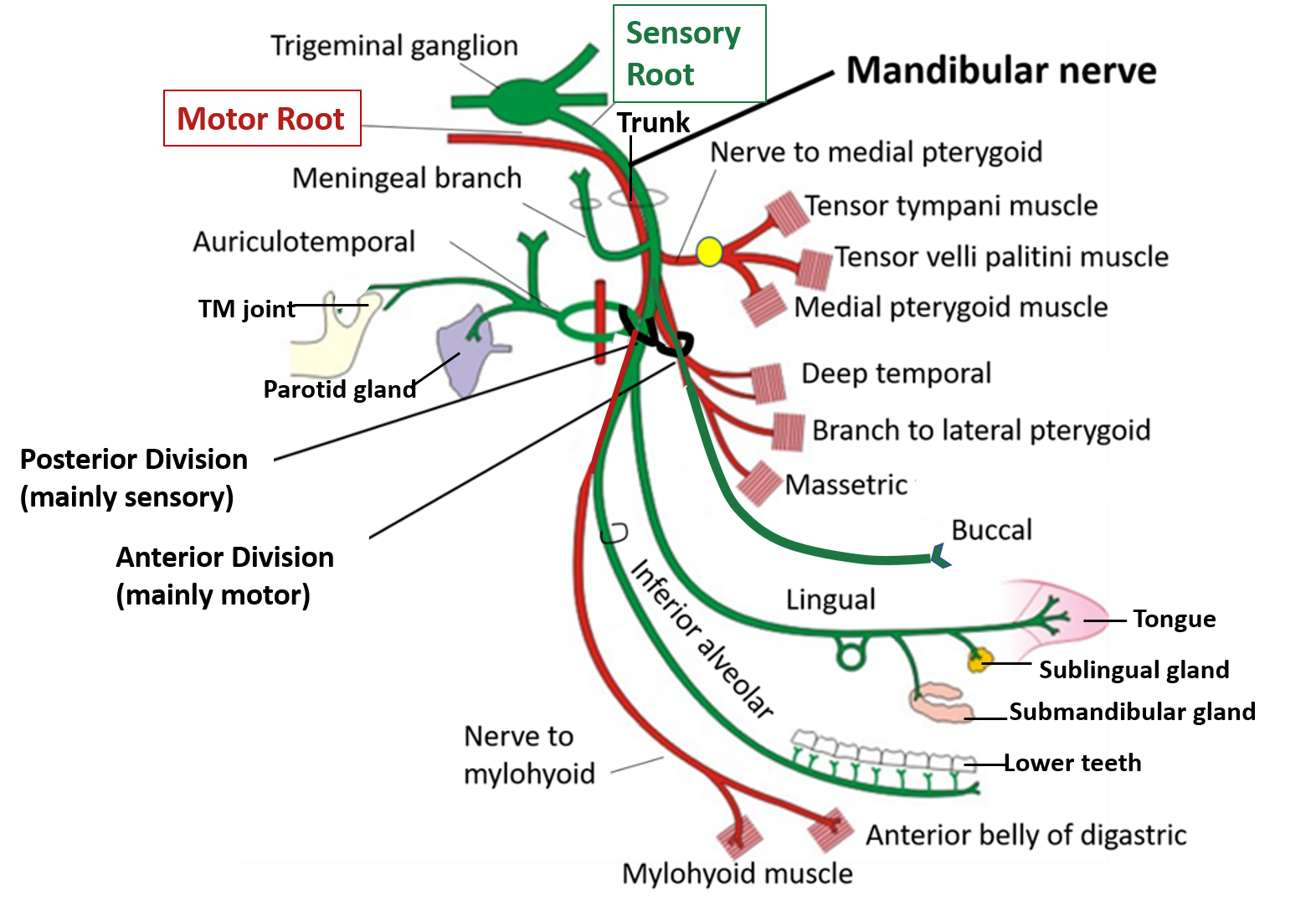
Branches of mandibular nerve
- From the trunk:
- Meningeal branch (sensory
- Nerve to medial pterygoid (motor)
- From the anterior division: Anterior division is mainly motor.
- Motor branches
- Massetric nerve
- Deep temporal nerves
- Nerve to lateral pterygoid
- Sensory branch
- Buccal branch
- From the posterior division: Posterior division is mainly sensory.
- Sensory branches
- Auriculotemporal nerve.
- Lingual nerve
- Inferior alveolar nerve: is mixed nerve.
- Sensory branches to lower teeth
- Motor branch: nerve to mylohyoid
- Sensory branches
- Motor branches
Structures supplied by mandibular nerve
- Sensory Innervation – Lower lip, chin, lower part of cheek, temple, auricle, external acoustic meatus, lateral surface of tympanic membrane, mucosa of lower part of mouth, anterior two-thirds of the tongue, part of dura of middle cranial fossae. Proprioceptive fibers from muscles of head.
- Motor Innervation – Muscles of mastication (temporalis, masseter, medial and lateral pterygoid), Tensor tympani, Tensor palatini, Mylohyoid, Anterior belly of digastric.
Applied Aspects
Effects of lesion of Ophthalmic nerve
- Paresthesia over region supplied.
- Loss of corneal – blink reflex.
Effects of lesion of maxillary nerve
- Paresthesia over the region supplied.
- Loss of sneeze reflex.
Effects of lesion of mandibular nerve
- Paresthesia over the region supplied.
- Paralysis of muscles of mastication.
- Loss of Jaw- jerk reflex.

